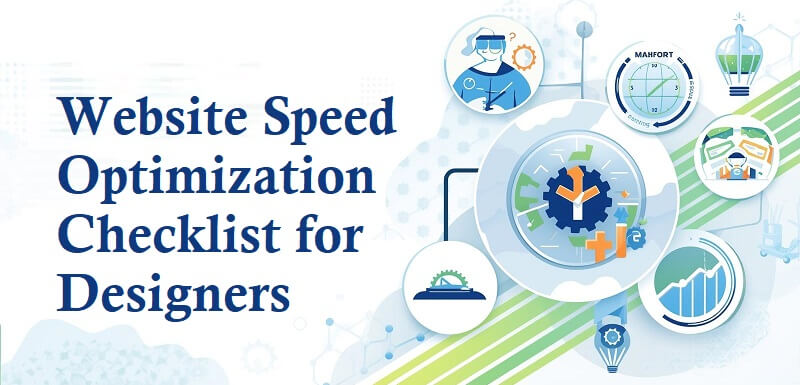In the digital world, pace is everything. A slow website can frustrate users, hurt search rankings, and reduce conversions. For web designers, performance isn’t just a developer’s issue — it’s a key part of delivering a great user experience. Whether you’re designing portfolios, eCommerce stores, or corporate websites, optimizing speed should always be part of your creative process. That’s where the Website Speed Optimization Checklist for Designers comes in — a step-by-step framework to ensure every website you build loads fast, performs smoothly, and delights users.
Understand Why Website Speed Matters
Let’s at last move away from the technical stuff. It is really crucial to see the reason behind the quickness in the workflow being one of the basic factors in any design success. A significant consideration is:
When thinking about UX design tips, one crucial aspect is website loading speed. After just three seconds of loading, nearly half (53%) of visitors will leave your site — and most won’t come back.
- SEO Ranking: Google’s Core Web Vitals at once degree performance and pace.
- Conversion Rates: A delay of even one 2d can lower conversions with the aid of as much as 7%.
- Mobile Experience: With most users browsing on smartphones, light-weight layout is a necessity.
Plan for Performance From the Start
Great overall performance begins in the design section. Before an unmarried line of code is written, designers ought to plan the layout, content, and assets with speed in thoughts.
Checklist:
- Use a content-first design approach — layout for readability, not clutter.
- Avoid unnecessary visible elements that grow web page size.
- Keep navigation easy and intuitive.
- Consider how every layout detail influences page rendering and cell responsiveness.
- Create low-constancy wireframes first to visualise simplicity.
Choose the right design tools
Use tools that help you test, optimize and export lightweight design elements.
Recommended tools for designers:
- Figma: Create vector-based designs that export custom assets.
- Adobe XD/Sketch: Provides compression options and asset previews.
- TinyPNG/Squash: Compress images before uploading.
- PageSpeed Insights and GTMetrics: Test prototype overall performance.
These tools help you become aware of bottlenecks even before the development degree.
Optimize Image Assets
Images are frequently the largest individuals to sluggish load instances. The purpose is to balance niceness and performance.
Checklist for Image Optimization
- Use WebP or AVIF formats — they’re 30–50% smaller than JPEG/PNG.
- Resize images earlier than uploading. Avoid relying completely on CSS scaling.
- Compress photographs.
- For responsive websites, use srcset to load suitable image sizes in line with the tool.
- Avoid heavy background photos. Use gradients or SVGs alternatively.
- Always outline width and peak attributes to avoid format shifts.
Pro Tip: If you operate hero images, practice lazy loading or use blurred placeholders for faster perceived loading.
Use Vector Graphics (SVGs) Whenever Possible
Scalable Vector Graphics (SVGs) load faster and scale superbly on any display screen.
Advantages:
- Small report size compared to raster photographs.
- Infinite scalability without losing quality.
- Animations and icons can be at once styled with CSS.
- Search engine marketing-friendly.
- Use SVG for logos, icons, images and easy animations.
- Typography and Web Fonts Customization
- Fonts can easily ruin your website if not handled carefully.
Best practices:
- Use system fonts where possible.
- Limit to two font families maximum.
- Choose variable fonts that include multiple styles in one file.
- Host fonts locally instead of using third-party requests.
- Preload critical fonts using the tag.
In order to make sure that text gets rendered quickly, apply the font-display: swap CSS rule.
Keep it in mind: Beautiful fonts must not affect the speed or accessibility of the website.
Simplify Layout and Reduce DOM Size
Complex layouts mean more elements for browsers to render, slowing performance.
Optimization Tips:
- Avoid deeply nested layers in your HTML structure.
- Use lightweight frameworks or none at all.
- Reuse components across pages to maintain consistency.
- Design with modular, flexible layouts that are easy to cache.
Minimalism in design naturally supports speed.
Minimize Use of Animations and Effects
Animations are beautiful — but can quickly slow your website if not optimized.
Checklist for Animation Performance:
- Prefer CSS animations over JavaScript.
- Avoid using GIFs for animation — use Lottie JSON or MP4.
- Limit parallax and scroll-triggered effects.
- Apply GPU-accelerated transitions (transform, opacity).
- Make sure animations amplify user interactions, not overshadow them.
The quick but subtle animation is preferable to the slow but bold one.
Focusing on Mobile Performance First
The design made for mobile first is essential as the majority of the users are on mobile phones for their browsing.
Design Guidelines:
- First, design vertical layouts that are smaller in size.
- Different screen sizes require responsive breakpoints.
- Make touch targets (buttons, icons) big enough.
- Avoid hover-only interactions.
- Test with real devices using Chrome DevTools’ mobile emulator.
A lightweight mobile design often performs well across all devices.
Optimize Color, Gradients, and Backgrounds
Rendering speed might be impacted drastically if heavy gradients, textures, or background videos are used.
Hints:
- Apply CSS gradients in place of raster images.
- In case you are using background videos, then compress them using HandBrake.
- Loop short videos instead of long ones.
- Avoid full-screen autoplay videos unless essential.
Keep visual appeal without compromising load speed.
Reduce and Merge Files Related to Design
Working together, designers and developers should make sure that the assets are sent in the most optimized formats.
Suggestions:
- Minify CSS and JS by applying Terser or CSSNano.
- Merge small scripts into a single file.
- Get rid of CSS selectors and animation libraries that were not used.
- Implement critical CSS in order to display above-the-fold content initially.
Advice: Send only the parts needed for the view of the first screen. Lazy load the rest.
Take Advantage of Lazy Loading for Media
Lazy loading slows down the loading of images or videos to the point where the user will scroll to them — thus, the initial page speed is improved.
Checklist:
- Add loading=”lazy” to tags.
- Utilize Intersection Observer API for unique lazy loading effects.
- Implement lazy loading on YouTube iframes or embedded videos.
Faster loading is perceived by users since the content shows up as they require it.
Make Use of Content Delivery Networks (CDNs)
A CDN keeps your files on the global servers, which makes the latency for the users worldwide smaller.
Benefits:
- Faster loading times no matter where you are.
- Lessening the main server’s bandwidth usage.
- Better consistency and uptime.
The most popular CDN providers are Cloudflare, BunnyCDN, Akamai, Amazon CloudFront.
If your client base is global, always suggest a CDN to get the best speed.
Core Web Vitals design guidelines
- Use consistent image and text sizes.
- Avoid pop-ups that shift layout.
- Ensure buttons don’t move after load.
- Preload large visual elements.
A designer who understands these calculations can create layouts that produce good results.
Customize third-party scripts
Third-party embeds – such as chat widgets, analytics or ads – can slow down pages.
Proposal:
- Load third-party scripts asynchronously.
- Limit external calls — use only essential ones.
- Replace heavy plugins with native solutions.
- Periodically audit your site’s network requests using Lighthouse.
Every external request adds milliseconds. Keep them to a minimum.
Test and monitor regularly
Website performance is not a one-time job – it requires ongoing testing.
Tools to Test Speed:
- Google PageSpeed Insights
- GTmetrix
- Pingdom
- WebPageTest.org
- Lighthouse (Chrome DevTools)
Track how design decisions impact real performance. Make testing part of your workflow.
Collaborate with Developers
Designers and developers share responsibility for performance.
Effective Collaboration Tips:
- Communicate file sizes, fonts, and responsive behavior early.
- Use common performance goals.
- Create prototypes that act like real loading scenarios.
- Capture and share the best practices for optimization during the transition.
It is always the end user who gains from designers and developers working together.
Performance and Accessibility Naturally Coexist
Usually, fast websites are also more accessible. Easy to navigate, clear order, and pictures that are pleasant to view are the advantages for all users.
Checklist:
- Semantic HTML should be applied to design prototypes.
- Visibility should be ensured through the use of high color contrast.
- Smooth interactions should be provided for assistive technologies.
- Pages should be loaded fully even on low-bandwidth connections.
Accessibility-first design is the first step to the creation of faster and cleaner websites.
Optimize for Caching and Compression
Caching is a technique that developers usually do, but designers still have to be aware of its impact on speed.
Simple Explanation:
Static files are saved in the computer of the user who is browsing the internet.
Gzip/Brotli compression helps reduce the file size to be transferred to the user.
The designers will be helping the caching process if they confirm that the names of static assets (like pictures and icons) change only when needed.
Develop a Culture of Speed-First Design
Lastly, let speed become a design philosophy. Every single creative decision —color, layout, typography, or imagery— will have a performance impact.
How to Maintain a Speed-First Culture:
- Include performance in every design brief.
- Audit design assets regularly.
- Use design systems that favor lightweight components.
- Educate team members about performance principles.
The speedier the loading of your website, the more satisfied your users — and customers — will be.
Conclusion
From the aesthetic aspect to the performance aspect, the designers are the ones who control the power. A pretty website but slow to load will definitely turn off people visiting it. But a highly optimized and fast loading good looking site will gain trust, boost SEO, and increase repeat customers.
Using this Website Speed Optimization Checklist for Designers you can create websites that are the best mix of art and technology — which means your designs can be seen clearly on any device and network no matter how slow.







